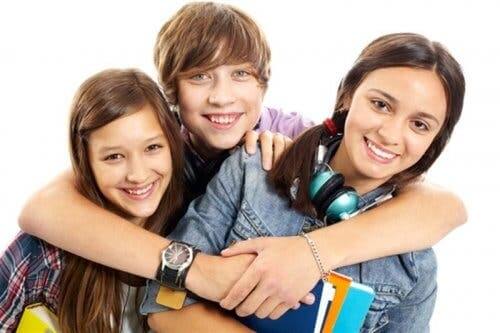The Types of Statuses that Develop Within Peer Groups


Written and verified by the psychologist Ana Couñago
Children and adolescents are in permanent contact with other people of the same age – whether at school, extracurricular activities, the park, etc. Therefore, the creation of emotional and social bonds among them is inevitable. In this sense, it’s important to know the types of statuses that develop within peer groups, as well as understand the consequences of assuming each role.
This is an especially relevant issue when it comes to the educational environment. That’s because the social relationships that develop during childhood and adolescence have an impact on:
- Psychological and behavioral development.
- The process of the development of one’s personal identity.
“We discover who we are gradually, through experiences. With hindsight, what appeared to have been the greatest problems are recognized as occurring during the times of greatest growth and self-awareness.”
– John F. Demartini –
Types of statuses that develop within peer groups

There are various components that come into play in establishing a person’s role and status within a peer group:
- Popularity and approval.
- Prestige and reputation.
- Social impact.
Based on these three factors, we can detect 5 different types of statuses that develop within peer groups:
- Preferred: The group perceives these individuals as possessing positive social and emotional competencies. Therefore, they’re popular and prestigious and make a significant social impact.
- Rejected: These members have the hardest time gaining the approval of the group. That’s because they display a series of behaviors that are unusual or considered by others to be negative. They tend to be aggressive, conflicting, immature, etc.
- Ignored: Individuals with this status often go unnoticed within the group because they’re shy, withdrawn, and solitary.
- Controversial: These members possess many positive as well as negative personal characteristics. Therefore, they have a significant social impact and intermediate popularity.
- Average: These individuals are in the middle when it comes to their social level. In other words, they don’t stand out within the group, because they’re neither greatly accepted nor rejected.
Phases in the formation of social status

- Precursor stage. Members assume certain expectations regarding the learning of certain behaviors and competencies that define a person’s social abilities. On that basis, each member begins to take on an identity within the group.
- Emergent phase. Members maintain continuous social interactions in such a way that each individual assumes a situation or role within the group.
- Maintenance phase. At this point, social positions become stable and influence the behavior that develops within the group.
- Consequence phase. Finally, the effects that taking on certain roles and assimilating a concrete status within a peer group become visible. On the one hand, those with a preferred, controversial, or average status enjoy healthy and balanced interpersonal development. However, on the other hand, those who are ignored or rejected manifest a clear deterioration in their adaptation. As a result, this influences their social abilities in a negative way.
Children and adolescents are in permanent contact with other people of the same age – whether at school, extracurricular activities, the park, etc. Therefore, the creation of emotional and social bonds among them is inevitable. In this sense, it’s important to know the types of statuses that develop within peer groups, as well as understand the consequences of assuming each role.
This is an especially relevant issue when it comes to the educational environment. That’s because the social relationships that develop during childhood and adolescence have an impact on:
- Psychological and behavioral development.
- The process of the development of one’s personal identity.
“We discover who we are gradually, through experiences. With hindsight, what appeared to have been the greatest problems are recognized as occurring during the times of greatest growth and self-awareness.”
– John F. Demartini –
Types of statuses that develop within peer groups

There are various components that come into play in establishing a person’s role and status within a peer group:
- Popularity and approval.
- Prestige and reputation.
- Social impact.
Based on these three factors, we can detect 5 different types of statuses that develop within peer groups:
- Preferred: The group perceives these individuals as possessing positive social and emotional competencies. Therefore, they’re popular and prestigious and make a significant social impact.
- Rejected: These members have the hardest time gaining the approval of the group. That’s because they display a series of behaviors that are unusual or considered by others to be negative. They tend to be aggressive, conflicting, immature, etc.
- Ignored: Individuals with this status often go unnoticed within the group because they’re shy, withdrawn, and solitary.
- Controversial: These members possess many positive as well as negative personal characteristics. Therefore, they have a significant social impact and intermediate popularity.
- Average: These individuals are in the middle when it comes to their social level. In other words, they don’t stand out within the group, because they’re neither greatly accepted nor rejected.
Phases in the formation of social status

- Precursor stage. Members assume certain expectations regarding the learning of certain behaviors and competencies that define a person’s social abilities. On that basis, each member begins to take on an identity within the group.
- Emergent phase. Members maintain continuous social interactions in such a way that each individual assumes a situation or role within the group.
- Maintenance phase. At this point, social positions become stable and influence the behavior that develops within the group.
- Consequence phase. Finally, the effects that taking on certain roles and assimilating a concrete status within a peer group become visible. On the one hand, those with a preferred, controversial, or average status enjoy healthy and balanced interpersonal development. However, on the other hand, those who are ignored or rejected manifest a clear deterioration in their adaptation. As a result, this influences their social abilities in a negative way.
All cited sources were thoroughly reviewed by our team to ensure their quality, reliability, currency, and validity. The bibliography of this article was considered reliable and of academic or scientific accuracy.
- Andrés-Andrés, M.R. (2013). Intervención socioemocional en alumnado rechazado de primer curso de Educación Primaria (Tesis doctoral). Valladolid: Universidad de Valladolid.
- Coie, J. D. (1990). Toward a theory of peer rejection. En S. R. Asher, y J. D. Coie (Eds.), Peer rejection in childhood (pp. 365-401). New York: Cambridge University Press.
- Dunphy, D. C. (1963), The social structure of urban Adolescent peer groups. Sociometry, 26, 230-246.
- Levine, J. M. Y Moreland, R. L. (Eds.) (2006). Small groups. New York: Psychology Press.
- Llinares, L. I. y Benedito M. A. (2007). El grupo de iguales como contexto de la inadaptación. Acciones e investigaciones sociales, (24), 65-99.
This text is provided for informational purposes only and does not replace consultation with a professional. If in doubt, consult your specialist.








